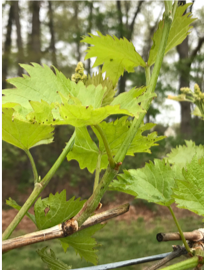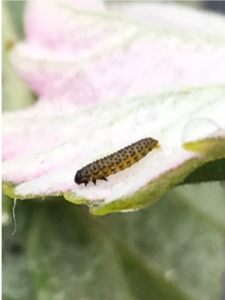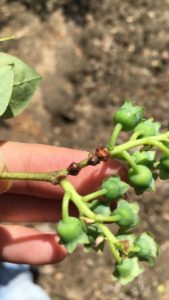Peach:
Plum Curculio (PC): PC adults are still active and will damage fruit if not controlled. Fresh injury is being found in several plantings, particularly in northern orchards. PC is a key pest to control during the first few weeks after petal fall.
Oriental Fruit Moth: First generation timings are updated below:
| OFM 1st Degree Day (DD) Timing | ||||
| Insecticide Type | ||||
| County/Region | Biofix | DD by 5/1 base 45 | Conventional
170-200, 350-375 |
Diamide
100-150, 300-350 |
| Gloucester – Southern | 4/8 | 443 | 1st – past
2nd – past |
1st – past
2nd – past |
| Hunterdon – Northern | 4/16 | 264 | 1st – past
2nd – 5/14-16 |
1st – past
2nd – 5/10-12 |
Tarnished Plant Bugs and Other Catfacing Insects: This is the other key insect complex at this time of year. Tarnished plant bugs will become more of an issue as temperatures warm and mowing and other ground cover activities become more common. General spray timing at this time of year should still be targeted for Oriental Fruit Moth and/or Plum Curculio (PC).
Bacterial Spot: Maintain tight covers with antibiotics until pit hardening. Typical antibiotics used include various copper and oxytetracycline formulations. From last week: Developing leaf infections were readily observed in every southern county orchard this past week. This infection occurred prior to the developing fruit being exposed, so there is no danger to the fruit. However, this does indicate that there is plenty of fresh inoculum for future fruit infections. Full covers with at least 100 gpa are recommended. For this week: Little to no increase in leaf infection levels have been observed.
Peach Scab: Maintain good coverage with captan or other effective fungicides until July where scab was an issue last year.
Rusty Spot: Rusty spot infections are ongoing until pit hardening. Maintain coverage with effective materials such as Rally, Rhyme, or potassium bicarbonate products.
Brown Rot: Maintain coverage with effective materials until pit hardening. Do not rely on sulfur alone unless a dry weather pattern develops. The Captan program, developed by Dr. Norm Lalancette would be a good program to follow, particularly as we get a little further into the growing season.
Apple:
Codling Moth (CM): The first codling moth flight has started. A biofix was set for CM on April 25th in southern counties and on May 1 in Hunterdon County.
| Codling Moth Degree Day Timing | ||||||||
| Application and Insecticide Type | ||||||||
| County Area | Biofix | Rimon:
75-100DD + 14-17 days later
|
Intrepid
150 + 450 DD Diamides – Altacor, Voliam mixes: (150-200 DD) + 14-21 days later |
Cyd-X, Madex
250 DD + every 7-9 days during brood hatch (later if first spray is an IGR) |
Standard Insecticides – Delegate, Avaunt, OP’s, carbamates, pyrethroids
250 DD + 550 DD
|
|||
| DD | 75 | 100 | 150 | 450 | 250 | 250 | 550 | |
| Southern | April 25 | past | past | 5/9 | Too far off | 5/17 | 5/17 | Too far off |
| Northern | May 1 | 5/7 | 5/10 | 5/16 | Too far off | 5/26 | 5/26 | Too far off |
Tufted Apple Budmoth (TABM): A biofix for TABM was set in southern county orchards on 4/25 and in northern orchards on 5/1. Nothing needs to be done for TABM at this point. More on TABM as we get closer to the first insecticide applications as predicted by the model.
Spotted Tentiform Leafminer (STLM): Adults are flying, but are not considered a pest target at this time.
European Apple Sawfly (EAS): This insect is active through bloom and into petal fall and first cover. Adult females lay eggs just under the skin of freshly set fruit, and the young larvae mine just under the skin. Where present, it is a primary target at petal fall. In orchards of mixed variety plantings, the petal fall spray for the entire planting is prolonged. This enables EAS to start damaging the first varieties where petals fell earlier before a petal fall spray could be applied to the entire block. DO NOT SPRAY ANY INSECTICIDE DURING BLOOM FOR THIS PEST! Doing this will kill bees, hurt pollination and fruit set, and is highly illegal!
Diseases: Apple Scab, Powdery Mildew, Cedar Apple Rust, are diseases of concern at this time. The NEWA scab models are predicting about 95% ascospore maturity by 5/6 in southern NJ. Primary apple scab spores are released during any substantial wetting and infection period. Cedar apple rust infections can occur anytime between pink and 3rd cover.
Fire Blight: In northern counties and late blooming varieties, continue antibiotic applications just prior to infection periods and up to 1st cover for shoot blight. Agri-Mycin may be applied after petal fall, but it must be rotated with oxytetracycline (Mycoshield or FireLine 17WP). Kasumin 2L may not be applied after petal fall. DO NOT use consecutive Agri-Mycin (strep) applications if 2 applications were already used during bloom. This will increase the likelihood of antibiotic resistance developing.
Grape
Grape Diseases: Diseases that need control now include Phomopsis; Powdery Mildew; Black Rot; and Downy Mildew. Last week the first phomopsis symptoms were seen in southern county vineyards.

Figure 1. Developing phomopsis on grape leaf and stem. Photo – David Schmitt
Grape Insects: Insects that should be scouted for now include climbing cutworms and flea beetles. These are sporadic pests that rarely need control. Flea beetles are the most common and can be found around orchard edges near wood lines. Flea beetle larvae were found at low levels in a southern county vineyard last week.

Figure 2. Grape flea beetle larva on leaf. Photo – David Schmitt
Scouting Calendar Tree Fruit Southern Counties
The following table is intended as an aid for orchard scouting. It should not be used to time pesticide applications. Median dates for pest events and crop phenology are displayed. These dates are compiled from observations made since 1995 in Gloucester County. Events in northern New Jersey should occur 7-10 days later.
Pest Event or Growth Stage |
Approximate Date | 2019 Observed Date |
| Bud Swell (Redhaven) | March 23 +/- 15 Days | March 25 |
1/4″ Green Tip Red Delicious |
March 31 +/- 13 Days | March 27 |
Pink Peach (Redhaven) |
April 4 +/- 15 Days | April 4 |
Tight Cluster Red Delicious |
April 9 +/- 13 Days | April 8 |
Oriental Fruit Moth Biofix |
April 9 +/- 13 Days | April 8 |
Full Bloom Peach (Redhaven) |
April 9 +/- 14 Days | April 9 |
Pink Apple (Red Delicious) |
April 14 +/- 12 Days | April 16 |
Codling Moth Biofix |
April 27 +/- 13 Days | April 25 |
Green Peach Aphid Observed |
April 16 +/- 16 Days | Not yet observed |
Full Bloom Apple (Red Delicious) |
April 22 +/- 11 Days | April 20 |
Petal Fall (Redhaven) |
April 22 +/- 10 Days | April 19 |
Petal Fall (Red Delicious) |
April 27 +/- 14 Days | April 29 |
Shuck Split (Redhaven) |
April 30+/- 11 Days | April 24 |
First PC Oviposition Scars Observed |
May 3 +/- 18 Days | April 23 |
Tufted Apple Bud Moth Biofix |
May 4 +/- 10 Days | April 8 |
San Jose Scale Crawlers |
June 2 +/- 8 Days | Not yet observed |
Pit Hardening Peach |
June 16 +/- 8 Days | Not yet observed |
Tree Fruit Trap Counts – Southern Counties
| Weekending | STLM | TABM-A | CM | AM | OFM-A | DWB | OFM-P | TABM-P | LPTB | PTB |
| 4/27 | 8 | 1 | 3 | 110 | 29 | 0 | ||||
| 5/4 | 4 | 5 | 6 | 34 | 17 | 1 | 0 |
Tree Fruit Trap Counts – Northern Counties
| Weekending | STLM | TABM-A | CM | AM | OFM-A | DWB | OBLR | OFM-P | TABM-P | LPTB | PTB |
| 4/6 | 0.3 | ||||||||||
| 4/13 | 2 | ||||||||||
| 4/20 | 10 | 0 | 0.2 | 0.9 | |||||||
| 4/27 | 9 | 0 | 0 | 4 | 9.5 | 0 | |||||
| 5/4 | 9 | 0.1 | 0.2 | 7 | 0 | 0 | 17.1 | 0.2 | 0 |
Blueberry
Plum Curculio (PC): Our numbers of PC adults were still high. PC adults are being found in both Burlington and Atlantic County fields. This week’s average for PC were 0.06 per bush with a max of 1 per bush. Adults are now laying eggs on developing fruit. Therefore, this remains the primary insect to control as soon as bees are safely removed.
Leafroller (LR) and Other Leps: The principal larvae being found are green fruitworm. This week’s average for LR were 0.04 per bush with a max of 0.6 per bush. The treatment threshold is 1 larva per bush, so in most cases these do not pose a problem. However, some gypsy moth larvae are also being found. These were first found on April 22, with only sparse numbers. During the past week they became present in both Burlington and Atlantic County fields, but at very low numbers, averaging only .001 per bush. In rare cases, up to .1 larva per bush is being seen. Even with the addition of gypsy moth larvae, no treatments are needed for this pest complex.
Lecanium / Terrapin Scale: One field was seen today (Tues) with overwintering Lecanium scale on the canes. This field also had Putnam scale during the season last year. So there are at least 2 species of scale present on this farm. The life cycles for Lecanium and Terrapin scales are different from that of Putnam scale, so controls need to be done at different times. Putnam scale is a hard scale and has 2 generations per year, while Lecanium and Terrapin scales are soft scales and have 1 generation per year. The soft scales overwinter as fertilized females which, in this case, will produce young crawlers by mid to late May. The visible females are now feeding. Therefore, since many growers will only be able to do a ground spray for the 1st 1-2 post pollination applications, soft scale control is suggested in the first or second sprays in order to target the first crawlers from the ground. Esteem 35WP @5oz/A is suggested for control if scales are present. Timing would be as late as possible during May, but applied with a ground sprayer with at least a 50 gal spray volume.

Figure 3. Lecanium scale on blueberry. Photo – Nick Freeman
Phomopsis: We are still seeing low levels of Phomopsis canker formation. Numbers are very low, with an average of .01% of terminals infected per bush.

